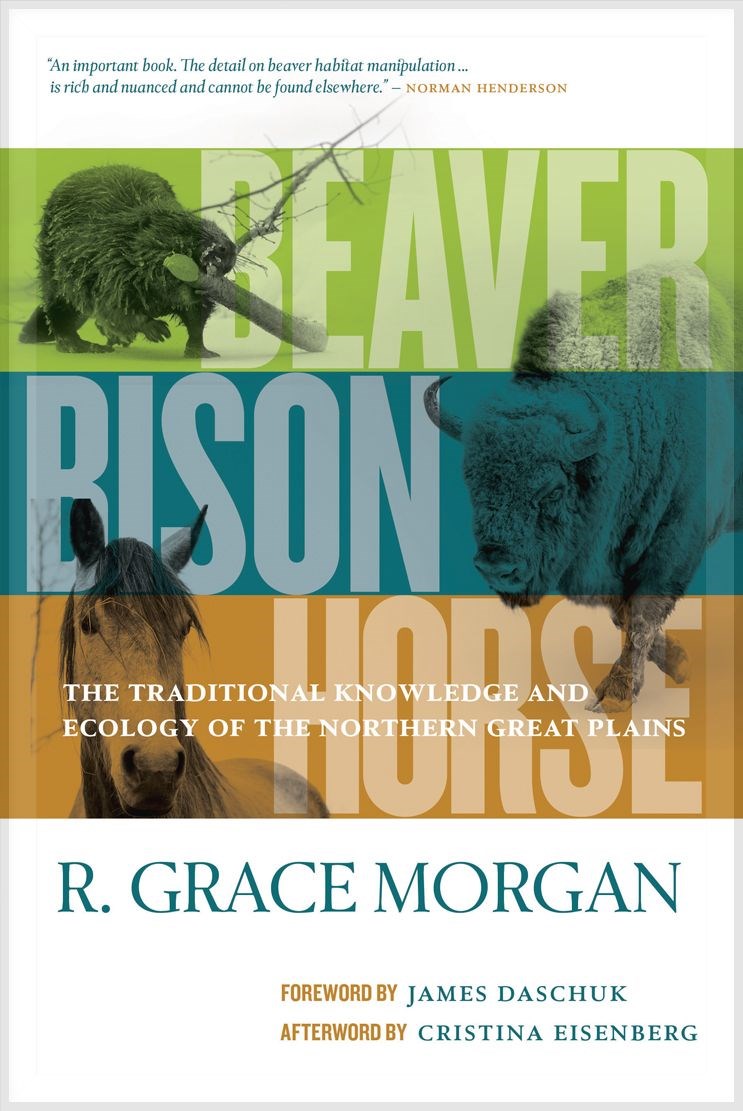A recently released book delves into the traditional importance of three well known animals; the beaver, the bison, and the horse.
The book, not surprisingly titled Beaver, Bison, Horse: The Traditional Knowledge and Ecology of the Northern Great Plains by the late R. Grace Morgan endeavours to be “the seminal, anthropological account of Indigenous peoples’ relationship with essential fauna of the Plains region in Canada and the US., according to the release from the University of Regina Press, with the book centering on “traditional knowledge and ecology from an age before colonial settler invasions.”
The book “features deep analyses of beaver, bison and horse agriculture and habitat manipulation, which sustained Plains inhabitants for thousands of years,” noted the release.
With the author passed Yorkton This Week was able to arrange an interview with Brian Morgan and Kim Morgan regarding the book, beginning with some insight into the woman behind the book.
Dr. R. Grace Morgan “was an anthropologist, archaeologist, and a scientist, deeply connected to the prairies and passionate about its ecological complexity and the sustainable practices that early Indigenous inhabitants had with the land and its animal occupants,” began Brian.
“In earlier times, Grace had also been an accomplished classical violinist and opera singer, artistic qualities that helped shape her innovative approach to research.
“Grace was also a wonderful cook who loved to entertain friends in her home.
“Another passion for Grace was reading science fiction novels.
“In every endeavor, she set a high achievement bar for herself and for her four children.”
Grace passed away in February 2016 from Ovarian cancer after many years of determined resistance.
Grace Morgan [née Hrytzak] was born in Rosthern, Saskatchewan and raised in the small town of Yellow Creek, where her father worked as a schoolteacher and principal, where cultural life revolved around the local Ukrainian community.
“Regina was her home base while working on the book. It was also relatively close to the Qu’Appelle Valley Complex, Cottownwood Creek and Wascana Creek systems, where she conducted site excavations and environmental surveys for the book,” noted Brian.
Brian said the book’s design actually reflects his mother’s own make-up in basic ways.
“Grace’s work is uniquely interdisciplinary, which is evident in the organization of chapters in her book, each one illuminating a different component of the Northern Plains ecosystem and the kinds of systemic awareness that Plains Indigenous Peoples would need in order to survive in a highly precarious environment,” he explained.
“Traditional prohibitions against the hunting of beaver exemplified this systemic recognition. Beaver damming practices guaranteed the provision of water in an environment susceptible to drought. These beaver-created water resources also served to attract bison herds in predictable ways, which supported Indigenous hunting practices on the Plains.
“A consistent feature of the book and Grace’s work in general, is its grounding in data and meticulous description of the evidence discovered.”
As for the basic idea of the book, Brian said it evolved over time.
“Grace’s MA studies and thesis, supervised by Professor George Arthur at U of R, was an important testing of her primary hypothesis, which forms the key idea for this book: that the Indigenous Peoples’ aversion to Beaver hunting on the Northern Plains reflected a system of ancient water management necessary for survival,” he explained.
“Evidence for this traditional wisdom could be found through a careful analysis of the regional setting (climate and geography), human-animal relationships, and the environmental, historical, and archaeological evidence available. Throughout her PhD studies and post-PhD research, Grace was able refine and expand her understanding of this traditional ecological knowledge.
“Though Grace published several important articles in field-leading journals, and presented her research in academic conferences, this is her first and only full-length book publication.”
But why did she feel that the book was worth writing?
“Grace always felt that her work on ancient environmental practices would be relevant to contemporary problems of climate change, global warming, and drought, which was especially relevant environmental problems in Saskatchewan,” said Kim Morgam. “She deeply respected Indigenous stewardship of the natural habitat, recognizing that this environmental wisdom was not recognized nor taught in white settler schools and society in general.
“Grace was also a public advocate for the kinds of Indigenous habitat management she studied, often sharing her research with farmers and encouraging them to not interfere with beaver activity on their properties.”
Being a scholarly work meant the writing process was at times difficult.
“The writing itself was not an easy process,” said Kim. “It did require a lot of preparation and, at times, supplementary research, including further study in Elk Island Park after her PhD was completed.”
And, there were challenges.
“There were actually two equally challenging aspects to this project,” said Kim noting one was the process of production and editing, over several years, of a posthumous book non-Indigenous scholar, occurring in the broader context of Canada’s Truth and Reconciliation Commission and its calls for action, and secondly reconstructing an ecology on the Northern Plains that no longer exists.
In the end Grace was generally happy with what she had created, said Kim.
“Mostly ‘yes’ in terms of being satisfied,” she said, adding the caveat “she was very passionate about her research and sometimes frustrated by its reception, recognizing that her work was ahead of its time.”
As for an audience, Kim said academics in related fields are certainly part of Grace’s target audience, adding “at the same time the book is of interest for people concerned about environmental issues, and those who wish to learn more about Indigenous life in Canada prior to European contact and its consequences.
“As Jim Daschuck, author of Clearing the Plains (2014) writes in the forward, “Grace Morgan has written an ecological lament for a lost way of life that took place in an environment that no longer exists.”




